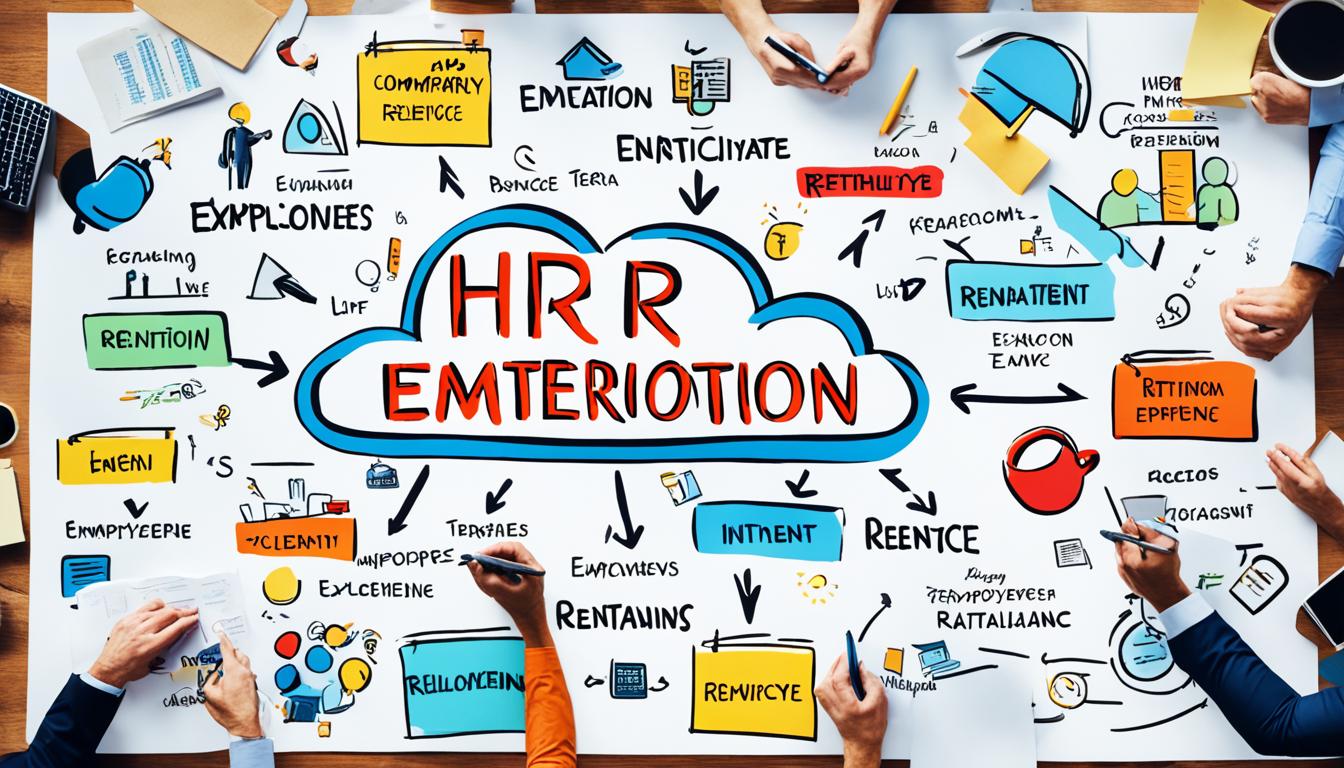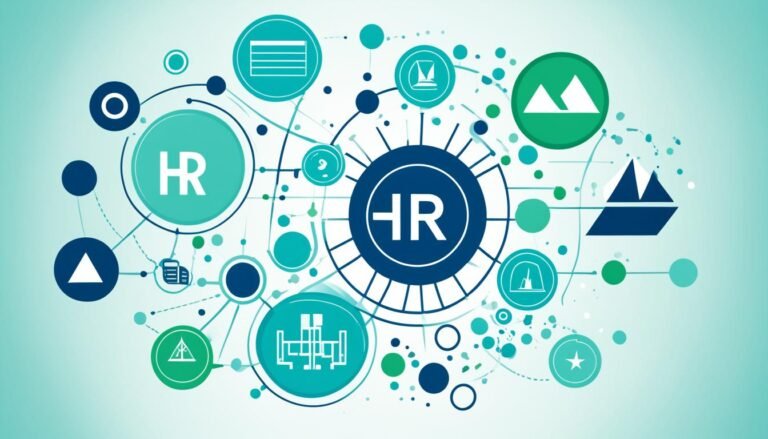A Guide to HR Employee Retention Programs
Managing for employee retention is crucial for organizations to attract and retain key employees, reduce turnover, and improve overall business performance. In this comprehensive guide, we will explore HR employee retention programs and provide you with key strategies and best practices to improve employee retention and enhance employee loyalty.
Employee retention programs are designed to address various aspects of an employee’s experience within the organization, such as job satisfaction, engagement, compensation, work-life balance, and recognition. By implementing effective HR retention initiatives, organizations can create a positive work environment that fosters loyalty among employees.
Key Takeaways:
- HR employee retention programs are essential for attracting and retaining top talent.
- By addressing factors such as job satisfaction, engagement, and compensation, organizations can improve employee retention.
- Employee engagement programs and recognition initiatives play a crucial role in enhancing employee loyalty.
- Implementing a retention plan for HR involves a comprehensive approach that considers various components of employee satisfaction and well-being.
- By following HR retention best practices, organizations can create a positive work environment that reduces turnover and improves overall business performance.
The Importance of Employee Job Satisfaction and Engagement
Employee job satisfaction and engagement play a pivotal role in effective employee retention programs. When employees are satisfied with their jobs and engaged in their work, they are more likely to stay with the organization, contributing to its success. Several factors influence job satisfaction and engagement, which organizations need to address to create a positive work environment.
Factors Affecting Job Satisfaction
- Respectful Treatment: Employees value being treated with fairness, respect, and dignity. A culture of mutual respect fosters a positive work environment that enhances job satisfaction and employee loyalty.
- Fair Compensation: Providing employees with competitive and equitable compensation is crucial. Fair pay ensures employees feel valued and recognized for their contributions, positively impacting job satisfaction.
- Trust: Building a culture of trust is essential for enhancing job satisfaction. When employees trust their leaders and feel their opinions are valued, they are more likely to be engaged and committed to the organization.
- Job Security: Employees desire stability and security in their roles. Job security gives them a sense of peace and allows them to focus on their work without worrying about sudden changes or layoffs.
- Opportunities for Skill Utilization: Employees are motivated when they can apply their skills, knowledge, and expertise in their roles. Providing opportunities for skill development and growth enhances job satisfaction and engagement.
Addressing these factors leads to higher levels of performance, productivity, and employee morale. It also reduces turnover and related problems, saving organizations significant costs associated with recruitment and training. Fostering job satisfaction and engagement should be a priority for organizations seeking to retain valuable talent and create a positive work environment.
Understanding the Drivers of Employee Retention and Turnover
Developing effective employee retention strategies requires organizations to have a deep understanding of why employees choose to leave and why others decide to stay. By identifying the drivers of employee retention and turnover, companies can make informed decisions to create a work environment that fosters loyalty and reduces turnover rates.
Employees leave organizations for various reasons, including inadequate salary, limited career advancement opportunities, poor work-life balance, dissatisfaction with management, and a negative company culture. These factors contribute to voluntary turnover, where employees choose to leave on their own accord.
On the other hand, employees are more likely to stay when they feel valued and appreciated, have opportunities for growth and development, and experience a positive work environment. These positive aspects contribute to reasons that employees stay and can help reduce involuntary turnover.
Understanding the drivers of employee retention and turnover is essential in addressing issues and implementing effective strategies to retain top talent.
Factors Driving Employee Retention:
- Competitive salary and benefits
- Opportunities for career advancement
- Positive work-life balance
- Strong and supportive management
- Positive company culture and values
Reasons Employees Leave:
- Inadequate salary and compensation
- Limited career advancement opportunities
- Poor work-life balance
- Unhappiness with management
- Dissatisfaction with company culture
By addressing these factors and ensuring that employees feel valued, organizations can proactively reduce voluntary turnover and create an environment where employees are motivated to stay and thrive.
| Drivers of Employee Retention | Reasons Employees Leave | Reasons Employees Stay | Voluntary Turnover | Involuntary Turnover |
|---|---|---|---|---|
| Competitive salary and benefits | Inadequate salary and compensation | Feeling valued and appreciated | Employees choosing to leave | Employees forced to leave |
| Opportunities for career advancement | Limited career advancement opportunities | Opportunities for growth and development | ||
| Positive work-life balance | Poor work-life balance | Positive work environment | ||
| Strong and supportive management | Unhappiness with management | |||
| Positive company culture and values | Dissatisfaction with company culture |
The Business Case for Employee Retention
Retaining top talent is crucial for organizations to weather talent shortages and minimize the costs of turnover. In today’s competitive business landscape, attracting and retaining skilled employees is more challenging than ever. Talent shortages can significantly impact an organization’s performance and productivity, hindering growth and innovation.
The cost of turnover is not just limited to the direct expenses incurred during recruitment, such as advertising, interviewing, and onboarding. It also encompasses the less tangible costs associated with decreased productivity, knowledge loss, decreased employee morale, and disruption to team dynamics. The true cost of turnover goes beyond financial implications and permeates every aspect of the organization.
In contrast, investing in effective employee retention programs yields substantial benefits. By fostering an environment that values and supports employees, organizations can cultivate higher levels of job satisfaction, engagement, and loyalty.
One way to quantify the business case for employee retention is by examining the financial impact of turnover. According to studies, the cost of replacing an employee ranges from 50% to 200% of their annual salary. This includes recruitment, training, lost productivity, and the time it takes for a new employee to reach the same level of performance as their predecessor.
To illustrate this point, let’s consider a hypothetical scenario. Company XYZ experiences an annual turnover rate of 15% across various departments. The average salary of an employee in this organization is $50,000. Using a conservative estimate, the cost of replacing each employee would be calculated as follows:
| Direct Costs | Annual Cost Per Employee | Total Annual Cost |
|---|---|---|
| Recruitment | $2,500 | $37,500 |
| Training | $5,000 | $75,000 |
| Lost Productivity | $2,500 | $37,500 |
| Total | $150,000 |
Based on this calculation, the total annual cost of turnover for Company XYZ would amount to $150,000. By implementing effective employee retention strategies, such as improving workplace culture, offering career development opportunities, and providing competitive compensation, the organization could significantly reduce these costs and allocate resources towards other strategic initiatives.
Furthermore, talent shortages can be even more detrimental to organizations, especially in industries where skilled professionals are in high demand. Retention becomes a critical factor in ensuring that an organization has the right talent to maintain its competitive advantage and drive growth.
“Investing in employee retention is not just a ‘nice-to-have’; it is a strategic imperative. Organizations that prioritize employee retention see improvements in productivity, employee morale, and customer satisfaction, leading to a significant competitive advantage in the market.”
Failing to prioritize employee retention can result in a revolving door of talent, negatively impacting workplace culture, team dynamics, and overall employee engagement. The ability to attract and retain top talent is a key differentiator in today’s talent-driven economy. Employers must recognize the importance of employee retention programs and invest in initiatives that promote loyalty, job satisfaction, and career development.
Key Components of Employee Retention Programs
Employee retention programs are comprehensive strategies that incorporate various components to foster employee satisfaction and engagement. By focusing on these key areas, organizations can create a positive work environment that promotes loyalty and commitment.
Effective Recruitment Practices
Implementing effective recruitment practices is crucial for attracting and selecting top talent. This involves crafting compelling job descriptions, utilizing various recruitment channels, conducting rigorous interviews, and assessing candidates based on relevant skills and cultural fit.
Comprehensive Onboarding and Orientation
Providing comprehensive onboarding and orientation programs helps new employees integrate into the organization more smoothly. This includes introducing them to company policies, culture, and values, as well as providing the necessary training and resources to excel in their roles.
Mentorship Programs
Establishing mentorship programs can greatly benefit both new and existing employees. Pairing experienced employees with junior staff members allows for knowledge sharing, skill development, and career guidance, which in turn fosters professional growth and engagement.
Competitive Compensation
Offering competitive compensation is crucial for attracting and retaining top talent. This includes providing fair and market-aligned salaries, performance-based bonuses, and opportunities for salary advancements based on experience, skills, and contributions.
Attractive Perks and Benefits
In addition to competitive compensation, organizations should provide attractive perks and benefits to enhance employee satisfaction and overall well-being. This may include health insurance, retirement plans, flexible work hours, paid time off, and employee discounts.
Wellness Offerings
Recognizing the importance of employee well-being, organizations should offer wellness programs and initiatives. These may include fitness activities, stress management workshops, mental health support, ergonomic workspaces, and access to healthy snacks.
Effective Communication
Establishing effective communication channels between employees and management is critical for maintaining transparency, trust, and engagement. This can be achieved through regular team meetings, town halls, feedback sessions, and accessible platforms for sharing ideas and concerns.
Continuous Feedback on Performance
Providing continuous feedback on performance allows employees to understand their strengths, areas for improvement, and align their goals with the organization’s objectives. This fosters growth, accountability, and a culture of learning and development.
Opportunities for Training and Development
Offering opportunities for training and development is key to retaining employees who are eager to learn and grow. Organizations should provide access to relevant courses, workshops, conferences, and mentoring programs that align with employees’ career aspirations.
Recognition and Rewards Systems
Implementing effective recognition and rewards systems helps motivate and retain employees by acknowledging their contributions and achievements. This can include formal recognition programs, spot bonuses, employee of the month awards, and public appreciation.
Work-Life Balance Initiatives
Promoting work-life balance is crucial for employee well-being and satisfaction. Organizations should support initiatives such as flexible work hours, remote work options, parental leave policies, and promoting a healthy boundary between work and personal life.
Flexible Work Arrangements
Offering flexible work arrangements such as remote work, compressed workweeks, or flexible scheduling can greatly contribute to employee retention. This enables individuals to better balance their work and personal responsibilities, leading to higher job satisfaction and engagement.
Effective Change Management
Implementing effective change management processes helps employees navigate organizational changes with minimal disruption. This involves clear communication, involving employees in decision-making processes, providing support and resources, and managing expectations during times of change.
Teamwork Promotion
Promoting teamwork and collaboration is essential for building a positive work culture and fostering employee retention. Encouraging cross-functional projects, team-building activities, and fostering a sense of camaraderie through open communication can greatly enhance employee engagement.
Acknowledgment of Milestones
Recognizing and celebrating employee milestones, such as years of service or project achievements, is an important component of employee retention. This can be done through company-wide announcements, personalized messages, or small celebrations to show appreciation for employees’ dedication and contributions.
Image: Illustration of employees collaborating on a project, representing the importance of teamwork in employee retention programs.
The Importance of Employee Compensation and Benefits
When it comes to attracting and retaining top talent, offering competitive employee compensation is paramount. Providing employees with fair and competitive salaries or hourly wages that reflect the living wage in their area is crucial. This ensures that employees feel valued and fairly compensated for their contributions to the organization.
In addition to competitive salaries, employers should also consider providing attractive benefits packages to enhance employee job satisfaction and mitigate the risk of turnover. A comprehensive benefits package can include health insurance, retirement plans, paid time off, and other perks that contribute to the overall well-being of employees.
Furthermore, employers should consider offering additional compensation and salary adjustments as employees gain more experience and take on increased responsibilities. This not only recognizes and rewards their growth but also keeps them motivated and engaged in their roles.
Employee perks can also play a role in attracting and retaining employees. These perks can range from flexible work arrangements, such as remote work options or flexible scheduling, to employee wellness programs or subsidized gym memberships. By providing these additional benefits and perks, employers demonstrate their commitment to supporting their employees’ overall well-being.
Ensuring that employee compensation and benefits are competitive and aligned with industry standards is essential in building a workforce that is satisfied and loyal. By investing in employee compensation and benefits, organizations create a positive work environment that fosters retention and long-term success.
| Benefits of Competitive Employee Compensation and Benefits | Employee Retention | Job Satisfaction |
|---|---|---|
| Attract top talent | ✔️ | ✔️ |
| Reduce turnover | ✔️ | ✔️ |
| Enhance employee loyalty | ✔️ | ✔️ |
| Improve employee morale | ✔️ | ✔️ |
Embracing Work-Life Balance and Flexible Work Arrangements
Supporting work-life balance and offering flexible work arrangements are essential strategies for employee retention. By providing options such as remote work, flexible scheduling, compressed workweeks, flextime, and partial telecommuting, organizations empower employees to achieve a better work-life balance. This flexibility allows employees to manage their time efficiently, resulting in increased job satisfaction and a stronger commitment to the organization.
Remote work is a growing trend in today’s digital age. It allows employees to work from anywhere, eliminating the need for commuting and providing a greater level of flexibility. With remote work, employees can create a work environment that suits their needs, resulting in increased productivity and satisfaction.
Flexible scheduling is another valuable approach that accommodates the diverse needs of employees. By allowing employees to set their own working hours within certain parameters, organizations enable them to balance personal and professional commitments effectively. This flexibility can help reduce stress and improve overall job satisfaction.
Compressed workweeks, which involve longer working hours on fewer days, can be beneficial for employees seeking extended downtime or additional personal time. This arrangement enables employees to better manage personal obligations while still meeting work requirements.
Flextime allows employees to choose their start and end times within a defined range, giving them control over their work hours. This flexibility ensures that employees can accommodate personal commitments or peak productivity periods, enhancing overall job satisfaction.
Partial telecommuting is an alternative work arrangement that allows employees to work remotely for a set number of days or hours each week. This arrangement provides employees with a balanced mix of office and remote work, increasing flexibility and productivity.
By embracing work-life balance and offering flexible work arrangements, organizations demonstrate their commitment to employee well-being and satisfaction. These initiatives contribute to increased employee retention, motivation, and overall organizational success.
Benefits of Work-Life Balance and Flexible Work Arrangements:
- Improved employee satisfaction and morale
- Increased productivity and efficiency
- Enhanced work-life integration
- Reduced stress and burnout
- Greater work engagement and motivation
- Enhanced recruitment and retention of top talent
| Flexible Work Arrangement | Benefits |
|---|---|
| Remote work | Eliminates commuting, increases flexibility, improves work-life balance |
| Flexible scheduling | Accommodates personal commitments, reduces stress, increases job satisfaction |
| Compressed workweek | Provides extended downtime, allows for personal time, improves work-life balance |
| Flextime | Gives control over work hours, accommodates personal and productivity needs |
| Partial telecommuting | Offers a mix of remote and office work, increases flexibility, enhances productivity |
Enhancing Employee Engagement and Recognition
Building employee engagement is critical for retaining employees. When employees feel engaged and motivated, they are more likely to stay with the organization and actively contribute to its success. Two essential elements of employee engagement are continuous feedback and recognition for their contributions.
Continuous feedback plays a vital role in ensuring that employees understand their performance expectations and have the opportunity to improve. By providing regular feedback, managers can address any issues promptly and help employees develop their skills and capabilities. This ongoing communication fosters a culture of continuous improvement and shows employees that their growth and development are valued.
Recognition is equally important for employee engagement. Recognizing employee contributions and achievements not only boosts their morale but also reinforces a sense of appreciation and value. When employees feel recognized and rewarded for their hard work, they are more likely to feel a sense of loyalty towards the organization. This, in turn, enhances their job satisfaction and motivation to go above and beyond in their role.
“Recognition is not just about rewards or bonuses; it’s about acknowledging the effort and impact that employees make in their work.”
To create an engaging and motivated workforce, organizations should establish clear channels of communication for continuous feedback and implement recognition and rewards programs. These programs can include simple gestures such as verbal appreciation, certificates of recognition, or team-wide acknowledgments for outstanding performances. It’s important to tailor recognition and rewards to align with employees’ preferences and values, ensuring that they feel truly appreciated.
By prioritizing employee engagement, continuous feedback, and recognition, organizations can foster a positive work environment that promotes loyalty and commitment among employees. When employees are engaged, motivated, and recognized, they become valuable assets to the organization and contribute to its long-term success.
Key Takeaways:
- Continuous feedback helps employees understand performance expectations and improve their skills.
- Recognition boosts employee morale, fosters loyalty, and enhances motivation.
- Implementing programs for continuous feedback and recognition is crucial for building an engaging work culture.
Conclusion
Effective HR employee retention programs are vital for organizations looking to attract and retain top talent, reduce turnover rates, and enhance overall business performance. To achieve these goals, organizations should focus on key factors such as job satisfaction, employee engagement, competitive compensation, work-life balance, and employee recognition.
Creating a positive work environment that prioritizes employee satisfaction and fosters loyalty and commitment is crucial. Regularly assessing and modifying retention strategies to meet the evolving needs and expectations of employees is essential for long-term success.
By implementing comprehensive HR employee retention programs, organizations can establish strong employee relationships, establish a talented workforce, and drive sustainable growth. It is imperative for organizations to prioritize employee retention strategies as a strategic investment that yields significant returns.







